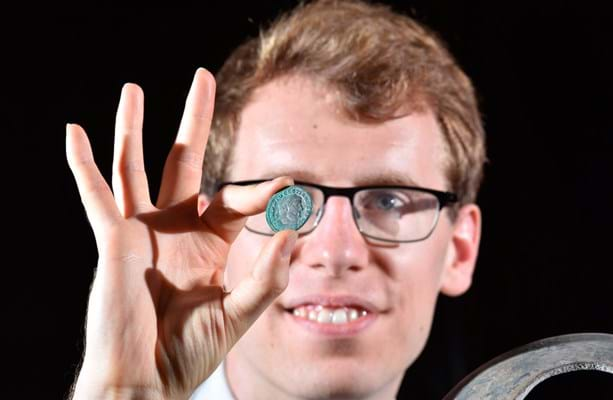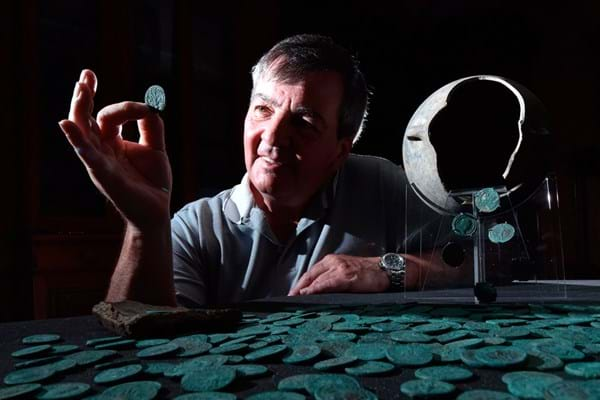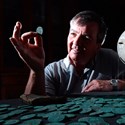At the time it was buried in 307AD near the village of Wold Newton, East Yorkshire, it was the equivalent of a legionary’s annual salary, three years for a carpenter or six years for a farm labourer.
The key amount in today’s money is £44,200 – the target of an appeal which has been launched to keep the largest Roman hoard of its type ever discovered in the north of England in public collections. The Yorkshire Museum in York now have four months to raise the money.
The coins were found by a metal detectorist, in 2014. They were buried during a period of great uncertainty in the Roman Empire and Yorkshire. It features coins depicting Constantius and also the first coins to proclaim his son, Constantine, as Augustus after he was made emperor in York.
Constantine came to Britain with Constantius in 305. Constantius died in July the following year in York (or Eboracum in Roman times).
The system of succession at the time demanded that another Caesar should become emperor but the soldiers in York immediately proclaimed Constantine their leader. It proved to be a pivotal moment in history. He is known as Constantine the Great for very good reasons.
“After nearly 80 years, and three generations of political fragmentation, Constantine united the whole of the Roman Empire under one ruler,” states historyofyork.org. “By 324 he had extended his power and was sole emperor, restoring stability and security to the Roman world.
“Constantine also abandoned Rome as the most important city in the empire, building a new capital modestly named Constantinople (now Istanbul).”
And of course: “Constantine’s strong support for Christianity had an incalculable impact on European history. He is said to have been converted to the faith in 312AD, although this has not been corroborated. At the time only around 10% of the Roman empire’s population was Christian.”
Constantine was the first emperor to allow Christians to worship freely, helping to unite and promote the faith. In 314, a year after Constantine’s edict on religious tolerance, Eboracum had its first Bishop. Along with the bishops of Londinium (London) and Lindum (Lincoln), he attended the Christian Council at Arles.
Stunning find
Andrew Woods, curator of numismatics at the Yorkshire Museum, says: “This is an absolutely stunning find with a strong connection to one of the most significant periods in York’s Roman history. No hoard of this size from this period has ever been discovered in the north of England before.
“It contains coins from the time of Constantius who died in the city and then the first to feature Constantine, rising to power. This was a pivotal moment in York’s history but also the history of the western world. It was also a time of great uncertainty in the empire, as different Roman powers looked to challenge Constantine’s claim as emperor.
“We hope to now save the hoard to make sure it stays in Yorkshire for the public to enjoy but also so we can learn more about this fascinating period as well as why it was buried and to whom it might have belonged.”
Richard Abdy, curator of Roman coins at the British Museum, adds: “The hoard represents an evocative illustration of the power politics at the time York was an imperial capital of the Roman World. The coins illustrate the several co-emperors all jockeying for ultimate power: York’s local team consisted of father and son Constantius I and Constantine I (the Great).
“Constantius was based in the city while dealing with the unruly Picts north of Hadrian’s Wall. On his death, Constantine was declared emperor by the army of Britain.”
A major part of the hoard along with the ceramic vessel is on public display at the Yorkshire Museum from July 16 to October 9. The museum has until October to raise the £44,200 (to donate, follow this link).
The hoard
- The coins are contained in a ceramic vessel. The coins, known as nummi, are around 3cm in size and represent the typical currency of the 4th century. It features coins depicting a number of Roman emperors including Constantius and Constantine.
- It is the largest hoard found from the period in the north of England and the second largest ever found in the country. The largest, the Fyfield Hoard, was found in 1944 and is now at the Ashmoleon in Oxford.
- The hoard was found by detectorist David Blakey in 2014. He filmed its discovery and immediately reported it rather than emptying it out which has allowed archaeologists the rare opportunity to excavate it in different layers to see how coins were added to the vessel
- Insect remains attached to some of the coins also offer another way of analysing the contents. All this means there is huge potential for getting a greater understanding of the period and why it was buried.









